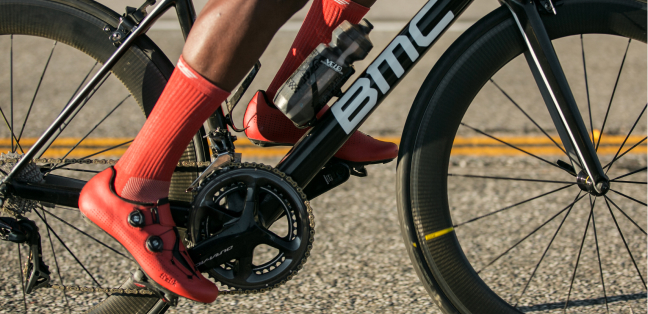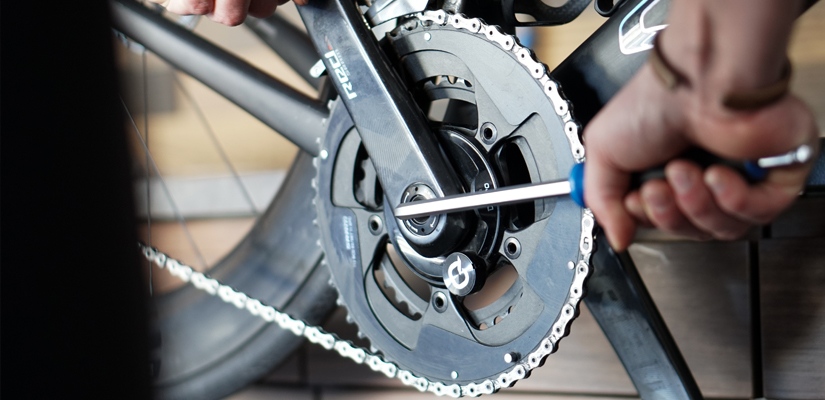A Guide to Bicycle Gearing: Choosing the Right Gears For Your Road, Gravel, and Mountain Bike

Having the right gearing can make or break your ride. But with the wide range of options available these days, choosing the right gearing can be an overwhelming and complicated task. Let’s get to the bottom of how gearing works and how to choose the right gears for your terrain and discipline.
For more information on choosing the right gearing, check out Ask a Cycling Coach Ep 278.
Gearing Basics
We take it for granted now, but bicycle gearing is an amazing thing. First introduced in the 1880s, the chain drive on a bike creates a mechanical advantage, so your pedals and wheels can move at different speeds. By shifting gears, you adjust this mechanical advantage and vary the torque transmitted to your rear wheel. It’s an incredibly effective application of simple physics.
Drivetrain Parts
As you push on the pedals, force is transmitted through a chainring (the toothed sprocket on your crank between your pedals), into the chain, and ultimately into another sprocket (referred to as a cog) attached to the hub of your rear wheel.
Most bikes have multiple chainrings, as well as multiple cogs arranged in a cluster called a cassette. Your derailleurs move the chain between different combinations of chainring and cog each time you shift. Varying the sizes of chainrings and cogs equipped on your bike lets you further customize your gearing to your needs.
Gear Ratios
Each combination of chainring and cog has a specific mechanical advantage. This is called a gear ratio and is found by dividing the number of teeth on the current chainring by the number of teeth on the cog. For instance, if your chain is on a 52 tooth chainring and a 16 tooth cog, the gear ratio is 3.25. The higher the gear ratio, the lower the torque transmitted to your rear wheel, but the faster it will spin. High gear ratios are useful when you’re moving quickly, such as in a sprint. Low gear ratios move your wheel more slowly but with increased torque, ideal for climbs.
Instead of referring to gear ratios, most cyclists express chainring and cog combinations by their respective number of teeth- 52/16, for example. This is a useful way to compare gearing on similar bikes, but it ignores the fact that wheel size plays a part. To incorporate wheel size into the equation, multiply the external diameter of your wheel/tire (in inches) by the gear ratio of your chainring and cog. This determines gear inches— how far your bike will move with one rotation of the pedals.
But even gear inches fail to take crank length into account, as longer or shorter crankarms change the mechanical advantage of the system. And no measurements incorporate efficiency, which can vary depending on sprocket size, chain angle, and other factors. If it’s starting to seem like gearing is more complicated than meets the eye, you’ve got the right idea— but luckily, it’s fairly easy to select the right gearing for your discipline and riding style if you keep a few key points in mind.
Road Bike Gearing
Many road bikes used to have three chainrings— an arrangement known as a “triple” crank. But with the advent of wider-range derailleurs and cassettes with more cogs, this arrangement has largely been phased out. Almost all road bikes now have cranks with two chainrings (known as a “double”). It’s also increasingly common to see road bikes with just a single chainring, commonly called 1x (pronounced “one-by”).
Double cranks on road bikes come with three common chainring sizes. Standard gearing is a 53-tooth big chainring and 39t small ring, so named because this used to be the default on most bikes. While standard chainrings are still common in the pro peloton, recent consumer bikes more commonly come with compact cranks, which have a 50/34 combination. Some bikes have mid-compact gearing that splits the difference at 52/36.
Road bike cassettes generally feature between 10 and 13 cogs, depending on which brand and level of drivetrain equips your bike. In most cases, the smallest cog has 11 teeth and the largest has between 25 and 32 teeth. The bigger the difference between the smallest and largest cogs, the wider the available range of gears, but the more dramatic and potentially disruptive the change you experience each time you shift.
Choosing the right gearing comes down to a consideration of terrain, personal preferences, and the limitations of your equipment. Ego should not be a factor, and contrary to what your friends might say, there’s no shame in easier gearing— especially if it equips you to ride more powerfully and efficiently.
Gearing for Road Climbs
If you’re riding or racing in a hilly area, easier gearing is the best option as it allows you to sustain a more efficient cadence while climbing. Unless you know you’ll be facing an unusual downhill sprint, there’s almost no situation in which you’ll regret having easier gears on a climb.
If your hills are relatively short (a few minutes or less) and not too steep, a mid-compact crank is ideal. If your climbs are steep and long, a compact crank is recommended. In both cases, a cassette with large cogs of 28-32 teeth will give you a wide range and excellent gear ratio. Check the capacity of your rear derailleur as some can only handle cogs up to a certain size.
Gearing for Flat Roads
If you’re a physically strong athlete who rides mostly flat roads, a standard crank might be a good option. This gearing prioritizes top-end power and can give you the edge in a very fast sprint, but will leave you under-prepared if you encounter any significant hills. For this reason, mid-compact cranks are a great option even on flat terrain. While they don’t offer quite the same sprinting performance as a standard crank, they do allow you more flexibility if you travel or ride into varied terrain.
Riders on flatter roads can also use cassettes with less of a range than those used for climbing. These cassettes are slightly lighter and offer the advantage of a subtler shift between each gear, but like standard cranks, they aren’t ideal for hills. Modern drivetrains have added more individual cogs to each cassette, so even wide-range climbing cassettes offer a mostly subtle transition from cog to cog.
Junior Gearing
Racers 18 and under are restricted in their gear choice for road races. This is intended to level the playing field between physically strong youngsters and their less-developed competitors.
In the US, juniors can’t have any gearing above 312 gear inches (26 gear feet). Depending on crank size, cassettes with a small cog of 12 or 14 teeth (instead of the usual 11) are used for this purpose.
Adaptive Training
Get the right workout, every time with training that adapts to you.
Check Out TrainerRoadMountain Bike Gearing
Much like road bikes, mountain bikes used to have triple cranks up front, but modern mountain bikes almost universally use just a single chainring. A 1x system offers several advantages offroad— it’s lighter, easier to use, and less prone to failure thanks to its mechanical simplicity. Also, wide-range rear derailleurs allow modern 1x drivetrains to achieve virtually the same gear range as a double or triple crank.
Compared to the road, mountain bikers do more climbing and tend to move more slowly overall. The highest speeds offroad are usually reached during periods of descending when pedaling is unnecessary or impossible. This is why mountain bike gearing is significantly easier than that found on the road, with chainring sizes most commonly ranging from 28–32 teeth, and 12-speed cassettes of cogs as large as 52 teeth.
Choosing the Right Gearing Offroad
Beginning mountain bike racers normally use a 28 or 30-tooth chainring. More experienced competitors often choose 32, 34, or 36-tooth rings, and pros may go even larger. Whatever your experience level, the single most important consideration is the ability to maintain steady power over decisive terrain features. If your course features a long, steep climb, sizing down is probably worthwhile to give yourself an advantage. If the course is mostly flat with just a few small hills, a larger chainring could be a better option.
Other concerns are technical. Chains are not as efficient at extreme angles, so gearing that encourages a straight chainline as often as possible is preferable. Chainring size can also subtly affect rear suspension kinematics, and most full-suspension bikes are designed around 32 tooth chainrings. Luckily, the effect is generally small and not noticeable to many athletes.
When in doubt, go for a smaller chainring and bigger cassette. It’s comparatively rare to wish for harder gearing in the heat of the moment, but very common to want an easier gear mid-climb.
Gravel and Cyclocross Gearing
Gravel and cyclocross bikes balance the needs of on- and off-road riding, so they mix characteristics of road and mountain gearing. Double chainring setups are typically smaller than those found on the road, with gearing combinations like 46/36 common in cyclocross and 48/31 on gravel. Single ring setups are very popular in both disciplines, offering the same advantages of reliability and simplicity they offer on mountain bikes. 1x chainrings are most often around 40 or 42 teeth on CX and gravel setups, but riders may choose much smaller or larger rings depending on their needs.
Gravel and cyclocross gearing is highly dependent on terrain. Gravel riders in relatively flat areas may use compact road gearing, while gravel drivetrains in very hilly areas can resemble those found on mountain bikes. Cyclocross races also vary widely, and athletes commonly adjust their gearing depending on the course and conditions.
